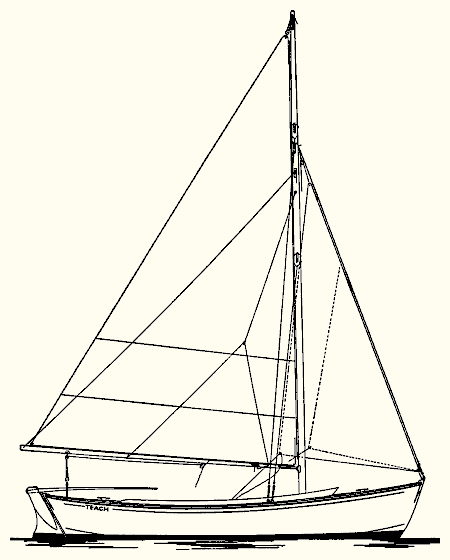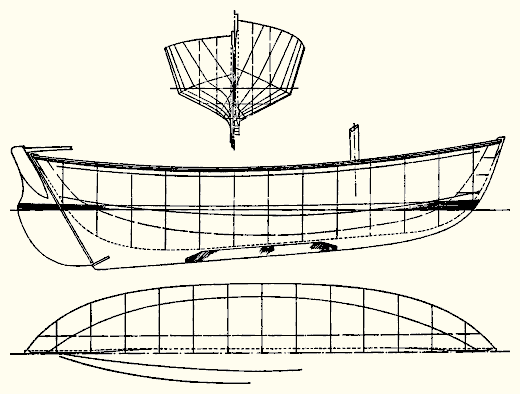

THE design for this month shows a most excellent little sailing boat. It has many characteristics which make it one of my favorite designs. Wrapped up in a trim little unit only 15 feet 6 inches over all, Teach is something more than the usual fair weather cockelshell. From stem to stern, keel to mast truck, this latest of the family is a tiny ship; furthermore an able one.

Teach's water line length is 13 feet 6 inches; her breadth is 4 feet 8 inches, and draft 2 feet. The freeboard at the bow is 2 feet 3½ inches, least freeboard, 1 foot 4 inches, and at the stern, 1 foot 9½ inches. Her sail area is 136 square feet. Lead ballast on the keel weighs 480 pounds with approximately 50 pounds of ballast inside for trimming purpose.
She is a double-ender of V bottom model and, as the title indicates, she is knockabout rigged; the mainsail carries 98 square feet, staysail, 38 square feet. It will be observed a storm staysail is provided. This is an opportune time to mention that a triangular sail which is set from the mast to the stem head. or any distance abaft this point, is a stay sail--not a jib, the name by which this sail is usually called. The mast stepping. standing rigging and running rigging is of the simplest character. The standing rigging consists of two shrouds and single head stay. Spreaders, jumper strut, runners and permanent back stay are unnecessary refinements in the rigging design of a little craft like Teach. The mainsail halyard is in double part: the staysail is in single part. These are small lightweight sails and easily hoisted and handled without the aid of winches or excessive purchases. The sail cloths should run with the leaches: omit battens, and insist upon useful long reef nettles. Present day young sailors entirely miss the fun of sailing with two reefs tucked in, storm staysail set and half gale of wind. My observation verifies the sad fact that on stormy, windy days all of the little boats, motor or sail, lonesomely walk around their moorings, with never a budding sailor in sight. For comfortable sailing one requires lazy-jacks, lines slung below the boom and leading aloft, into which the sail lowers and is contained. Another handy practice is to leave the sails bent on the spars, either protecting them with sail covers or waterproofing the sails. This saves the chore of forever taking the sails ashore and rebending them every time the boat is used. The mast and boom will be solid using galvanized iron rigging and turnbuckles for the staying. This will prove quite satisfactory.

The arrangement shows a comfortable cockpit with seating room for two; side seats and center thwart, ample deckroom, and nothing in the way of legs and feet. There are watertight bulkheads fore and aft providing ample flotation in case of swamping, comforting shipmates in any kind of boat. Teach steers with a long white ash tiller, and of course has her rudder hung on her stern post. There is no provision shown on the plans for an engine; however, if fitted with a Savage bracket, an outboard motor might he used for power.
This simple and practical sailing boat would be ideal as a class in which to learn the art of sailing and seamanship--there is a great deal of difference between the two. She will prove to be safe, comfortable, and reasonably fast; specially under the urge of strong winds and a bobble of sea. Her long straight keel makes grounding a simple matter and hauling out even more simple. The long keel also contributes to self-steering without in any manner effecting the little packet's ability to come about in a bit of a chop. If built closely to the form and specifications indicated in the plans Teach will balance well and be a joy to sail and own.

And now about the name--a most important item; of boats, you know, should have appropriate names. I have, found it is no small matter to select a name that perfectly fits a particular boat. Well "Teach" is an affectionate name our family has for Mrs. Shirley K. Brittner; Shirley teaches handicapped children struggling for an education in the Stamford Public Schools--little tots and older ones; kindergarteners with deep trusting eyes; sixth graders with eyes that reflect the courage and faith of divinity. And, little or big, all of them are inspired by the understanding and love of "Teach." So here is a tribute to a lovable young woman and a name worthy of gracing the design of a boat; it should be lettered in gold leaf and blessed with a cross.
In an article about the Atkins in WoodenBoat #169, author Daniel MacNaughton had this to say about Teach: "If there is a simple boat that can offer the Herreshoff 12 1/2 some competition for the title of best small keel daysailer, Teach might be it. Her large stern deck gives a secure feeling and helps to ensure that crew weight will be kept amidships where it belongs in such a small boat, and there is a lot of useful space for seating a small crowd or cruising with a boom tent. Her double-ended character is something out of the ordinary, and combined with the long keel, ample ballast, and easily handled rig, she will be a reliable and reassuring boat to sail."
If she is built as shown in the plans and in accordance with this text, Teach will be the envy of many eyes and a little boat which will be hard to part with. So forget not the gold leaf nor the cross.